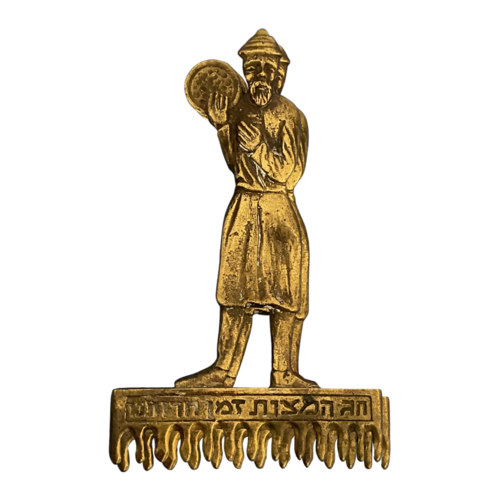
Museum Musings
April 2023

Matzah Puncher, 19th century
A gift to the Abraham and Natalie Percelay Museum of
Temple Emanu-El by Mr. and Mrs. Fred Strasmich.
Matzah Madness: It’s That time of Year….Again
What is it about this holiday that causes grown men to groan, and grown women to hyperventilate? Is this not the hag where we recline, a’ la the Greek symposium, as we discuss the important issues of the day, like recalling our journey from slavery to freedom? Aye, there’s the rub. We are supposed to imagine ourselves as slaves in Egypt. So, to put us in that mindset, some sage elder came up with his idea: Chain yourself to your kitchen, clean and cook, cook and clean…with the rest of the family, the Greek chorus, standing idly by, reminding you that there is a method to this madness. When the actual Pesah holiday and Seder meal finally came to pass, we began to understand how the preparation: cooking and cleaning and cleaning and cooking is a minute simulation of the drudgery and “pain” felt by the Israelites. (I do not mean to trivialize the meaning of avadim hei-inu [“we were slaves.”]) But somehow, this home exercise sets the tone for this holiday. The exhaustion of the preparation soon gives way to the release and exhilaration of the ensuing eight days.
We all know that the iconic symbol of Passover is matzah, and we also know its origins. In their haste to escape from bondage in Egypt, the Israelites did not have time for their bread to leaven. Tradition mandates that we not only eat matzah, but that we also explain its significance. There is a paradox in the meaning of matzah: it is our freedom bread; yet it also the bread of affliction, lechem oni, made of water and flour, the meager fare of Jewish slaves in Egypt. Many interpretations surround this contradiction. Rabbi Menachem Schneerson, the late Lubavitcher Rabbi, suggests the basic theme of Pesah “enables us to undergo a personal exodus from Egypt by transcending our individual limits.” By eating the bread of affliction, lechem oni, we internalize, literally, the bread of the poor and hungry who are without arrogance. By contrast, he suggests, leavening becomes bloated as it rises, suggesting egotism and pride. Consequently, one might say, hametz is a physical embodiment of the inclination to evil. Matzah, as the bread of affliction, and the bread of freedom, also emphasizes the fine line between slavery and freedom. It implies that no one is free unless we are all free.
In modern times, matzah is usually machine made, in flat squares. In past centuries, when matzah was hand-made, it was customary to incise designs on the matzah, in place of the standard rows of perforations we see today. Pictured above, is a matzah puncher, used to incise the holes onto the matzah, in the era before machines fabricated the holes. The matzah puncher, pictured here is a 19th century replica of a 15th century model, and was a gift to the Abraham and Natalie Percelay Museum of Temple Emanu-El by Mr. and Mrs. Fred Strasmich.
Some Jews prefer special shumurah (guarded) matzah, carefully supervised from field to oven — uncontaminated, baked no longer than eighteen minutes, and round. This matzah is similar to matzah of ancient times and represents spiritual purity. In ancient times, this type of matzah was the only bread allowed on the sacrificial altar.
So, as we begin our preparations for Pesah, let us be mindful that it is a privilege to be able to cook and clean, clean and cook, to celebrate this hag-ha-matzot, surrounded by family and friends. The slavery…and the liberation that our ancestors experienced so many generations ago, for us resonates anew….and before we know it, may we all have the privilege to experience, and to appreciate Matzah Madness once again.
--Ruth Page, Museum Director
Contributions to the museum are a special way to remember those you wish to honor on memorialize send your donations to the synagogue. Attention: Museum
